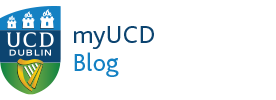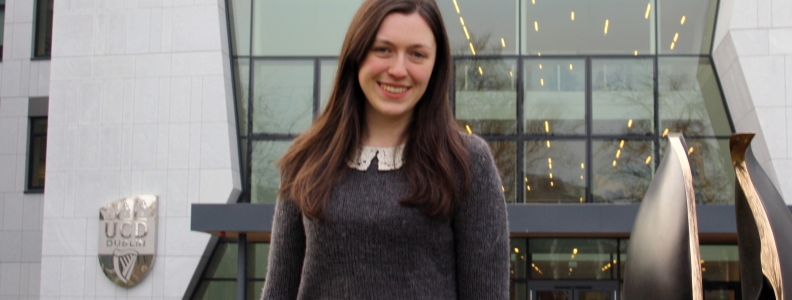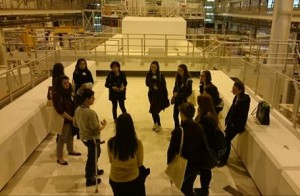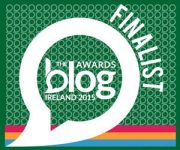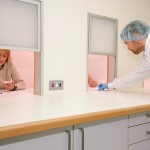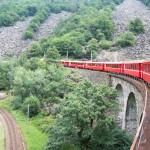2016 Conference for Undergraduate Women in Physics – Lána Salmon
Before attending the 2016 Conference for Undergraduate Women in Physics, I asked myself – why a conference for women? After getting support from UCD School of Physics to attend the 4 day annual conference in Oxford University, I walked into a room of 100 Undergraduates, researchers, industry workers and academics at the forefront of physics. As the only one attending from UCD, I was nervous and excited to meet women with a common interest – physics.

My badge – after meeting many people, these badges became very important for being reminded of people’s names!
Our first mixer was held in Lady Margaret Hall, Oxford – the first women’s college in Oxford. The old dining halls and architecture were just like Hogwarts. Although overwhelming we all instantly got talking- about our courses, Universities, favourite coding languages and much more. It wasn’t long before I realised the importance of a conference for women – and the conference hadn’t even begun yet!

The dining hall where we had our meals was very like the great hall at Hogwarts. The walls were lined with portraits of the past presidents of the college- all women!
An early start on day 2 began with a welcome lecture from the organiser of the conference, Professor Daniela Bortoletto. A professor at the University of Oxford and member of the ATLAS collaboration at CERN, she asked us to keep asking ourselves one question ‘Why a conference for women?’. As it turns out only 8% of Physics Professors in the UK are women. This conference is aimed at encouraging women in physics and getting a glimpse into the life of a woman in physics.
With this in our minds we headed to the Rutherford Appleton Laboratories. These state funded labs are situated on a huge campus filled with building after building of curiosity-led research. RAL deals with 1/10 of the data from CERN and houses the Central Laser Facility where supernovae are recreated using lasers.
We were introduced to a panel of women, all of whom work at RAL, and heard about their different backgrounds and jobs – from particle accelerator supervisors to space mission leaders. They told us about the internships and supports available to us such as the Daphne Jackson Trust, which allows funding for women who return to STEM after having children.
They gave us advice on choosing PhDs – consider at both the subject and the supervisor. They also introduced a topic which would be of central importance to the conference – Impostor Syndrome. This is an experience felt by many women of feeling incompetent and not worthy of their positions. They told us about their coping strategies – to continually remind yourself of how hard you have worked, and have a good work-life balance.
We were lucky enough to have a tour of the Neutron and Muon Accelerator at RAL. It is used as a microscope for condensed matter and nanomaterials research, and to test the effect of solar neutrinos on electronics. After leaving RAL, I had a new outlook on what a future in physics could be like – not just University research, but real applied experiments.
Day 3 of the conference was a day of talks and panels. We heard from a variety of speakers such as Professor Haida Lang. Haida began as a researcher in Astrophysics looking at the expansion of the Universe. She used this knowledge to fuel her career change to Archaeology. She now uses telescopes and x-ray techniques to image and conserve art. Haida made me see that physics can be applied to many areas and that a career change is never too late.
Lastly we had a panel from a variety of physics graduates who went on to become teachers, business analysts, medical physicists, science communicators and many more. We got the opportunity to ask them about their journeys and experiences. Possibly the quote of the conference came from Professor Amanda Cooper-Sarkar – she told us of how she couldn’t marry someone who didn’t have a mutual appreciation for Heisenberg’s Uncertainty Principle. I think she summed up why all of the women at this conference got along so well – our love and enthusiasm for physics.
Our evening consisted of a banquet dinner and then Café Scientifique – which turned out to be like speed dating except with physics researchers. We got to speak to people who helped discover the Higgs Boson, Astronomers and Laser Physicists. Asking them for advice and hearing their stories was inspiring.
The last day of the conference began with a tour of the Oxford Laboratories. I got to see Professor Bortoletto’s lab, where she is building the next Silicon detector for the Large Hadron Collider. We had to get into suits because the detectors are so sensitive to dust and dirt.
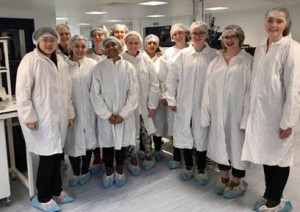
All dressed up to see the silicon detectors being made for the Large Hadron Collider in the Oxford Laboratories.
At the closing remarks Professor Bortoletto reminded us of the beginning of the conference. Why a conference for women? I think that we all knew the answer. 4 days of getting to know amazing women and learning from researchers, industry workers and academics inspired me more than I can explain. It became clear to me that things may not always go to plan but that physics is a fast changing and exciting industry where it is possible for women to lead and support one another.
Throughout these lectures and activities I got to know some amazing women from all over the world. The girls from Trinity College were very welcoming to me, being the only girl from UCD, and I am glad to say we became good friends. I made connections with people who will no doubt be leaders in the physics industry in the future, and who I will continue to keep in touch with.
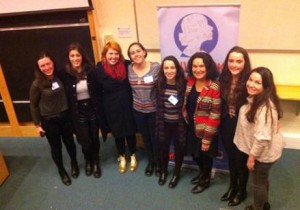
Myself and the girls from Trinity College Dublin with the organiser of the conference Professor Daniela Bortoletto.
I left this conference with a new outlook on physics, women in physics and the future. You can never plan for what is going to happen, but there are always people going through the same. The physics community is a welcoming and exciting community, and this conference showed me that being involved in it is a rewarding and fun experience. And lastly, I made connections that I hope I will keep throughout my time in physics, wherever it will take me.
I would like to thank UCD School of Physics for supporting this trip and to the organisers and attendees of the conference. I hope to have many more experiences like this in the future and would encourage women in physics to apply next year and exceed your own expectations!
This blog was written by Physics with Astronomy & Space Science student Lána Salmon.

